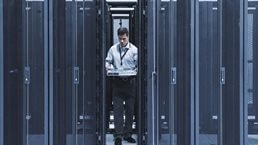Since the onset of the COVID-19 crisis, many of the changes reshaping how we work and live rely on technology. Because technology ties so much of every company together, CIOs have had a unique view into what’s been going on and how to manage it.
While women continue to be significantly underrepresented in such tech roles—with fewer than 20 percent holding these jobs—a group of 60-plus women executives in operations and technology gathered recently to hear from two leading women CIOs: Rhonda Gass and Klara Jelinkova. Led by McKinsey’s Gayatri Shenai in a webinar on June 5, 2020, the two shared how they’ve led their teams during a time when technology is more important than ever, the challenges of balancing careers and families while working from home, and what they’ve learned to date as they navigate these unprecedented times. An edited version of their remarks follows.
Challenging assumptions
Gayatri Shenai: As you went through the first few months of the crisis, what were some of the fundamental assumptions you had to challenge alongside your team?
Rhonda Gass: We in IT became the front line for at least half of the employee base. We were stepping into areas we had never gone before. The team never said no to anything but instead said, “I don’t know, but I’ll find out.”
Klara Jelinkova: We are on a single campus, and for us to go to fully contactless support was a big shock for people.
If a machine breaks, we now have a way to drop it off, get it disinfected, repaired, disinfected again, and then picked up. I would have never thought we were going to get there. And now we are there, and nobody wants to go back.
Another area of change has been around business processes. When everybody had to go online and work from home, we discovered all of these shadow processes that people had that required paper. And all of a sudden, our business-process group had to help figure out how to digitize them.
I think all of this has made people much more accepting of what digital can do and made them open to trying new things.
Supporting people
Gayatri Shenai: How are you ensuring success of your employees at home?
Rhonda Gass: First and foremost, we give people the permission to push back and say, for example, “I have a two-year-old, and she’s screaming right now. I’m not going to make the meeting.” We’re all dealing with crazy things right now, and we’ll figure it out.
We’ve also gotten feedback from people that they feel like remote working has leveled the playing field. Everyone is now a little widget on a screen. People don’t want to lose that.
So we’re already thinking about and planning for how we can make a more immersive, collaborative experience when we get to the point where some people are in the office and some are remote.
Klara Jelinkova: As far as team support goes, it’s also important to work with both direct reports and managers and make sure that everybody gets the message to give people a break.
It’s one thing to say it, but what has been helpful for us [to drive home this message] is to have town hall meetings with the managers and reinforce how serious we are about supporting people.

After the first wave: How CIOs can weather the coronavirus crisis
Caring for ourselves
Gayatri Shenai: Talk to us about how you are practicing self-care and what seems to work.
Klara Jelinkova: It’s a little thing, but I start every one-on-one by asking the person how they’re doing. And I do not move off that topic until I actually get an answer.
In these virtual Zoom meetings, we are all very “all business.” But when you go to physical meetings, you always have some chitchat before and after a meeting. I think we are missing that as humans. Incorporating this into your Zoom meetings might be helpful because people can connect with you a little bit better.
Another thing we’re working on is ensuring that people take vacations in the summer. But it’s very hard [to get people to truly take a break]. When people respond to emails [while on vacation], I actually send personal notes to them saying, “Please do not respond to emails. You’re on vacation, and you really need to take it, because when we come back in the fall, it’s going to be even harder.”
Rhonda Gass: We’ve recently taken our hour-long meetings and cut them down to 45 minutes. And 30-minute meetings are now scheduled for 25 minutes, so at least there’s some breathing room in between meetings.
Now, do we run over time because we know that the 45 minutes can really go an hour? Absolutely. But it does give you a little bit of downtime in between meetings so that you can click the next button, go get a glass of water, do whatever you need to do. That’s important.
We’ve also tried to make Fridays no-meeting days, where we don’t expect anyone to say yes to a meeting on a Friday.
I have taken the time I would have spent commuting in the evening and turned it into my evening walk. And if I have an hour block during the day, I sometimes can steal away and take a short walk, which I would have never done before. And I make a point to call someone while I’m outside on my walk and let them know that doing this is OK. It clears your head. It gives you brand-new thoughts.
Renewed value on technology
Gayatri Shenai: What are some of the changes you’re seeing within your organizations that you think will be more permanent and that you would like to stay?
Klara Jelinkova: I have seen a renewed recognition for IT across the enterprise and deep pride within the IT professionals. People have really started to understand how they connect to the mission in a very tangible way.
I think hanging onto that pride that technology people have taken in their work is going to be really important.
Rhonda Gass: I couldn’t agree more. I think we have some visibility today that we never had before, where the whole organization sees how important what we do is, day in and day out.
So we’ve now got our commercial teams thinking, “How do we take more of the sales process remote? How do we get our customers comfortable with that?” And guess who they want at the table with them to help figure this out? An IT person.
We’ve got security solutions where we sell automatic doors, and we’re augmenting those with other touchless products and tracking and software that can complement those products. Again, who are the individuals and the kinds of people wanted at the table, those who have the digital expertise to help them chart that course? It’s the IT group. So there’s a lot of pride, I think, in IT expertise that may have never been highlighted before.
Lessons learned
Gayatri Shenai: As we reflect on recent months, what would you say is the biggest learning from this crisis?
Klara Jelinkova: I think we are more resilient than we give ourselves credit for. And our organizations are more resilient than we realized. And so my big learning is the strength that people have brought to this crisis. And I’m talking about the three crises that we are living through right now: financial, COVID-19, and the kind of unconscionable acts related to race that we are seeing in America today.
Rhonda Gass: I do think there is something to the saying, “Never let a crisis go to waste.” It’s been a really great opportunity to reinforce the importance of life-cycle management of our technology base and to get clean and stay clean. All of those things have been hugely beneficial.
Klara Jelinkova: For me personally, I got to a point a few weeks ago where I was going through a pretty major burnout. And so I’m really learning to pay attention to warning signs in myself. And that has been helpful.
Before the crisis, there was a rhythm that we all had, punctuated by board meetings or semesters or whatever. But now it’s very continuous. And so I think the more personal thing that I’m going to take away from this crisis is paying more attention to myself.

